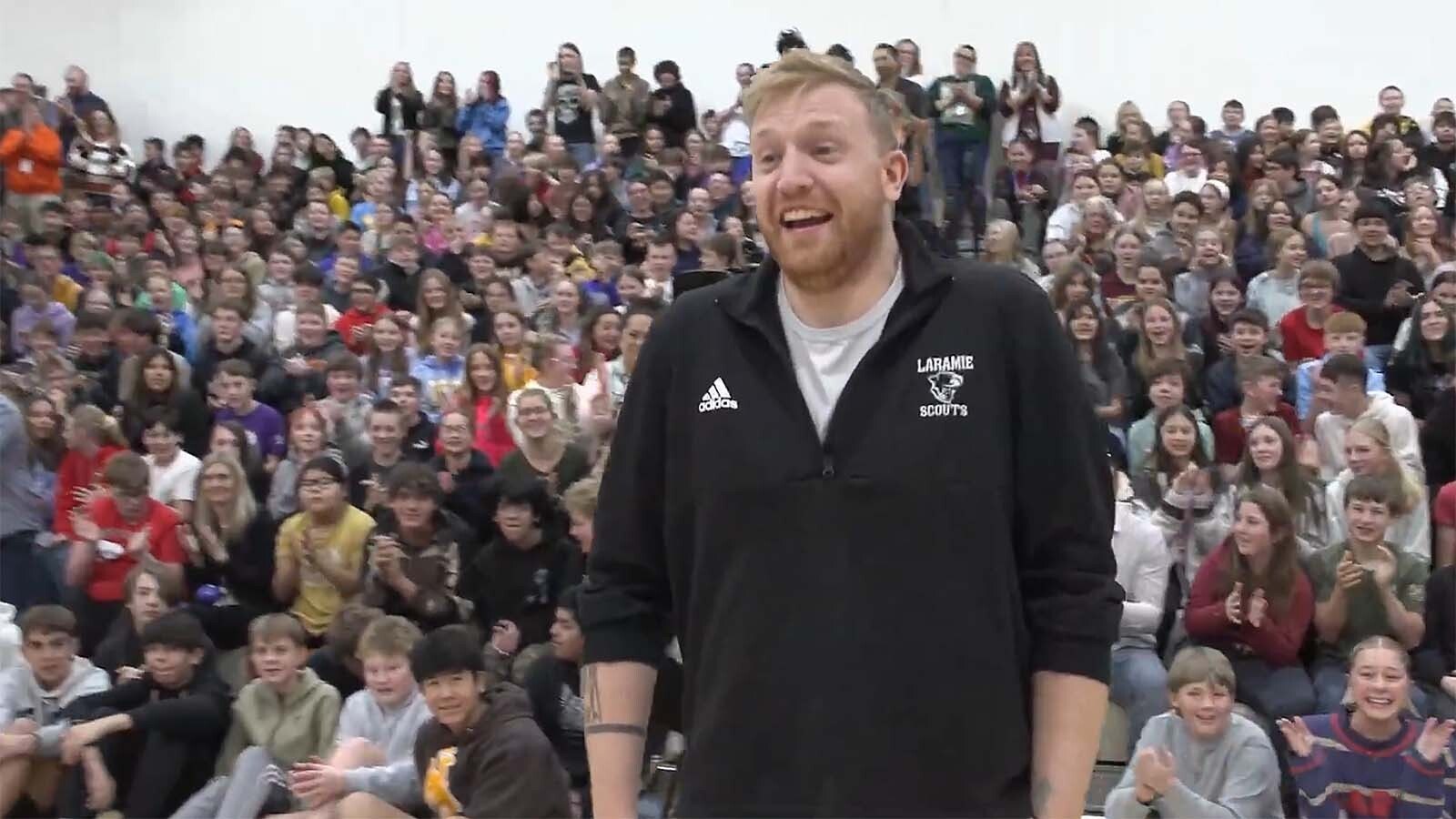CHEYENNE — Like a lot of girls who grew up in the days of the first lunar landing in 1969, Marcy Curran heard often that girls aren’t supposed to be interested in space and the stars.
“My folks were going to Denver that day, and I was in junior high,” Curran recalled about July 16, 1969, the day of the moon landing. “I guess I was maybe 13 or 14, something like that. And I wanted to stay home and watch them land on the moon.”
Curran’s mom jumped to a completely different conclusion about her daughter’s real motive.
“Oh, you are not interested in science,” her mother said, shaking her head. “No. No girl is interested in space.”
Curran’s mom thought her daughter just wanted to stay home and “mess around.”
But she was wrong, and Curran, like any teenager, made sure to let her mom know that. Often.
The next time something big was happening in space was the Apollo 13’s return to earth. This time, Curran had no trouble convincing her mom that her interest in space and the stars was for real.
“Mom didn’t bat an eye,” Curran said. “She goes, ‘I’ll call the school and tell them you’re gonna be late.’”
Curran learned an invaluable lesson from all of that. One that’s been a North star ever since. The stars are where it’s at for her. So, no matter who told her it’s not for girls, she wasn’t going to listen to that, no not at all.
Curran has built a life around the stars since then, full of treasured memories that sparkle. Literally.
“I tell people this all the time,” Curran said. “I must be easily amused, because things that sparkle are what I like.”
By day, that’s jewelry. But at night, it’s the stars.
Her Very Own Observatory
Curran is quietly celebrating a big milestone this year. It will be her 40th year as a founder of the Cheyenne Astronomy Society. She’s the only founder left who is still active in the group, and who still even lives in Cheyenne.
Each month, Curran sends out a zippy little newsletter with all kinds of tidbits to amuse the star lovers of southeast Wyoming.
That includes a list of interesting things to see in the night sky that month, as well as anything big that’s happening in the space and astronomy sector.
She also plans monthly programs featuring experts who can help local astronomers, like photographer Jan Curtis, as well as occasionally literal rocket scientists or others who have worked in astronomy and space.
The club also hosts a few star parties each year at Camp Jack, the overflow for Curt Gowdy State Park. Camp Jack is much darker than Curt Gowdy because it doesn’t have overhead lighting and makes a perfect venue for star parties.
Her next big star party, though, is likely to be at her new home out in the country, where she and her husband Marty recently moved, all so they could build their very own observatory.
“I always tell people astronomy can cost you from nothing to more than you ever want to spend,” she says, laughing. “I mean, you can do it with your eyes alone. You can download star maps online. And a lot of people will just get apps to use on their phone or tablet.”
Or you can go all in like the Currans. Sell the home with 2 to 5% interest rates and trade it for a mortgage with almost 7%, and count yourself lucky, because you not only have the perfect star party backyard, but an ideal spot for your very own observatory.
“I love it out here,” Curran said. “I can look out my window and see the stars and stay warm.”
About That 10-Inch Pair Of Binoculars
Curran has completely different interests than her husband’s when it comes to the stars.
She likes the easy targets. The stuff like meteor showers that take no effort to find but are so calming to watch.
“Marty likes to hunt down things he can barely see,” she said, chuckling. “And he’s into taking pictures of them. We approach it differently, but collectively we look at a broad aspect of astronomy.”
Marty caught the star bug from Marcy.
“Our first date was, actually, I took him to a star party with me,” she says. “And that’s when he got hooked. He’s very much into it now. And he takes great pictures with his telescope, which I can use for work, and I stick them in our club newsletter.”
Her husband has enjoyed building their own personal observatory, but it’s not the first time he’s built his own gadgets to seek out the stars.
“He built a 10-inch pair of binoculars,” Curran said. “He took two, 10-inch telescopes for that.”
The contraption is the size of a gas grill and it even has wheels.
“He made handles for it, like you’d have on a wheelbarrow,” Curran said.
The observatory is 8- by 16-foot and looks a bit like a shed. But it’s got a roll-off roof and a wall that drops down.
It’s functional already, Curran said, though Marty is still putting the finishing touches on it.
“He’s going to get a computer to automate some stuff,” she said. “So he can run it remotely.”
That will mean star parties can happen indoors — where it’s nice and toasty and there are no bugs — with cocoa or wine in hand.
“That’s my ideal,” Curran said.
Lucking Into The Perfect Job
Curran’s fascination with the stars started when she was just a girl. She blames her dad for that, just a little bit.
“My dad was a typical Wyoming guy,” she said. “He was an outdoors man. He liked to hunt, fish, four-wheel in the snow, and camp.”
Curran doesn’t particularly like camping all that much. It’s cold. There’s dirt. And worst of all, bugs.
“I truly don’t like to camp,” she said, laughing. “Which is kind of funny considering the hobby I’ve chosen.”
Camping is one of the best times to see the stars. That makes camping worth it, despite the dirt and ugly bugs.
“You just can’t beat the Wyoming sky up in the mountains,” she said. “It’s just fantastic up there.”
Her dad didn’t really know much about the stars beyond finding the Big Dipper, but that didn’t stop her little curiosity bug from biting.
When Curran noticed some astronomy classes at a local college, she decided to take them. Little did she know that was going to lead her to a job eventually teaching astronomy courses for 20 years, even though she had no degree in that topic.
“The local science teachers would pass the class around,” she recalled. “They do it for two or three years, then pass it to another science teacher. And, every time one of them wanted to quit, they’d tell the dean to call me.”
Curran turned them down several times, pointing out she’s not a teacher and has no degree in astronomy.
But eventually, one of the teachers talked her into trying it.
While her very first class as a teacher was awful, she took some education classes to learn better methods, and, after that, her class became one of the most popular.
“I could easily fill three sessions to the max,” she said. “I always got good reviews and, in my 21 years there, I got outstanding adjunct four times.”
Eventually, a new administration decided they didn’t want a teacher without an astronomy degree teaching the class, so Curran was let go.
“That was ironically for the best,” Curran said. “I lost my mother that summer, and had I been teaching, I wouldn’t have had the time to spend with her that I did.”
The Cherry Bomb
Curran’s first telescope was a five-and-dime model, one she never quite figured out how to use. It was too much like trying to take a cocktail straw out to find something in the night sky.
“The key to a good telescope is you need a really good tripod,” she said. “And most of the dime store telescopes won’t work with a tripod worth a darn.”
When she heard about an astronomy club, Curran eagerly showed up, only to find the group was disbanding. They told her about the Edmund Astroscan, a telescope that was designed with the novice in mind.
The Edmund Scientific Corp. stopped making these cute, little red cherry balls in 2013, after the mold for the telescope’s plastic bodies broke. But Curran believes it is still one of the best telescopes around for beginners. It features a ball-and-socket mount that allows novices to effortlessly move and point the scope. No intricate alignment procedures required.
It has no parts that can easily break, and brings a wide-angle field of view, meaning crisper, more complete images of things like the Moon, star clusters, planets, and even galaxies.
One of the first things she found with her new telescope was Halley’s comet rounding the sun in 1986. She also used the scope, which she nicknamed the “Cherry Bomb,” to see Comet Hyakutake, the long-tailed comet.
“It was the dead of winter,” Curran recalled. “There was a foot of snow. But we set up my little cherry bomb in a drift of snow, and we kept going out about every 20 minutes for a couple of hours to watch its tail switch as it went around the sun.”
She also used it to see stars pop in and out of the rings of Saturn.
No Plan To Retire From Stars
More recently, Curran has lucked into a job with earthsky.org, as one of their night sky editors. At first, it was just 10 hours a week, but it didn’t take long before they wanted more of what Curran could offer.
“I’ve been doing their videos, about five or six a week, and then I do their night sky charts,” Curran said. “I also help with other editing, and it’s really funny, because I feel like I just lucked into the teaching job, and now I’ve lucked into this job.”
She also lucked into a husband who loves the stars as much as she does — enough to drive all the way to Texas for the eclipse, eating M&Ms with her all the way. Not to mention years of sharing the stars with others, both young and old alike. What she’s noticed there is it doesn’t seem to matter how young or old a person is. The “ohs” of amazement sound the same.
Curran has never regretted her determination to chase the stars.
In her book, the stars are for everyone, no matter their age, no matter their gender, no matter where in the world they’re from. Following the stars, ignoring the naysayers, has brought her everything important in life, from stupid space jokes to love and work in between.
Renée Jean can be reached at renee@cowboystatedaily.com.












